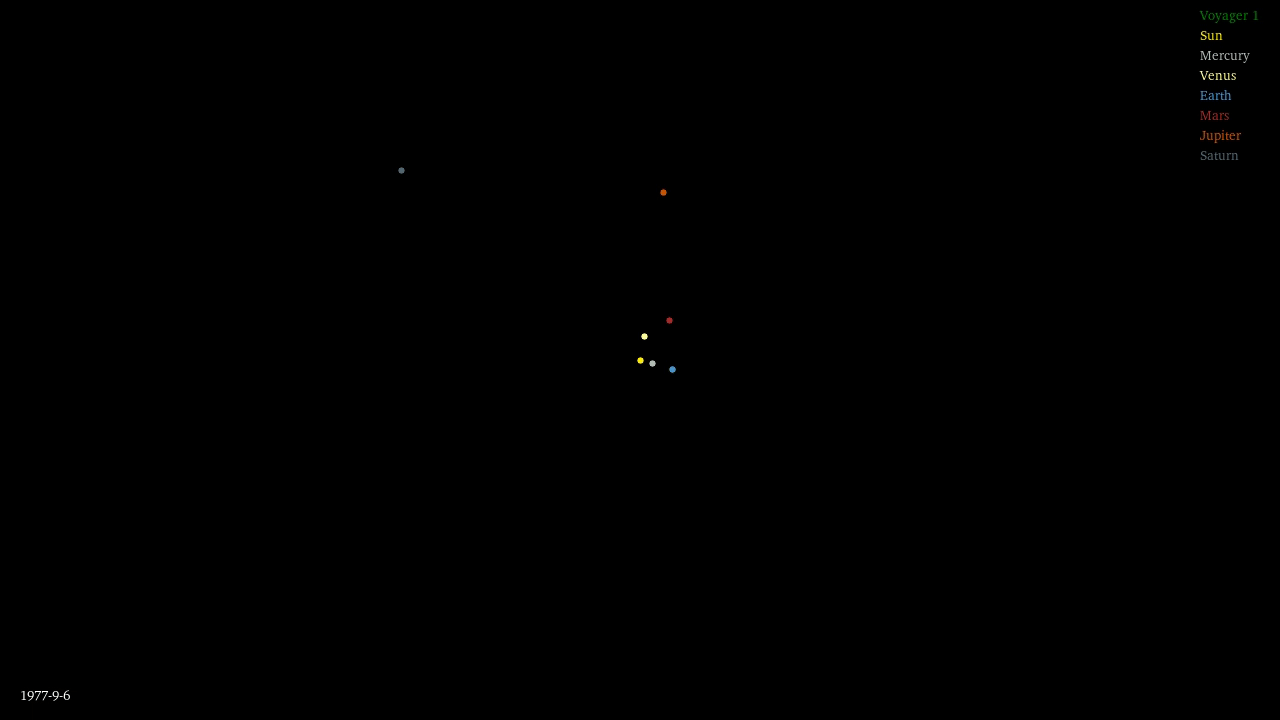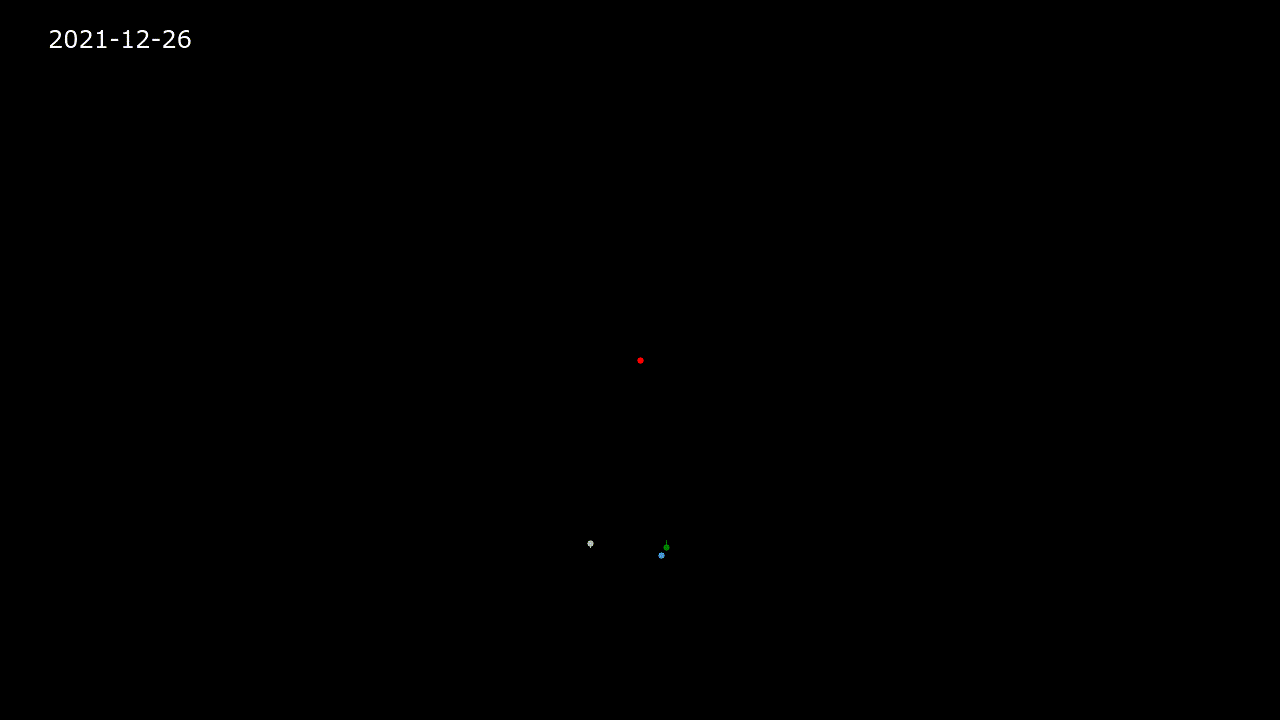@mmomtchev/orbitron
v1.0.2
Published
Generator of orbital animations using NASA/JPL Horizons API
Downloads
24
Maintainers
Readme
orbitron
orbitron is a tool for making orbital animations including spacecraft trajectories using the NASA/JPL Horizons API.
It uses ideas from the unpublished ad-hoc tool by Phoenix7777 used for creating many of the illustrations on Wikipedia.
Usage
Install from npm:
$ npm install -g @mmomtchev/orbitron
....
$ orbitron
Usage: orbitron [options] [command]
Options:
-h, --help display help for command
Commands:
animate [options] Generate orbital animations using NASA/JPL Horizons API
lookup <string> Lookup bodies in the Horizons database
help [command] display help for commandLookup the spacecraft you need
Find the Horizons ID of Voyager 1:
$ orbitron lookup Voyager
Voyager 1 (spacecraft)
-31
Voyager 2 (spacecraft)
-32
Generate the animation
Create a slower animation for the first part of the mission (launch to Saturn), include only the inner planets, Jupiter and Saturn, set one day per frame speed (one month per second), linear projection.
$ orbitron animate --start 1977-09-06 --stop 1982-01-01 \
--out voyager1-part1.mp4 --days 1 --legend \
--proj lin --origin sun --body -31=green \
--body sun --body mercury --body venus --body earth \
--body mars --body jupiter --body saturnCreate a faster animation for the second part of the mission (Saturn to outer Solar System), include only the gas giants and Earth, set 10 days per frame (almost an year per second), square root isometric projection:
$ orbitron animate --start 1980-01-01 --stop 2024-01-01 \
--out voyager1-part2.mp4 --days 10 --legend \
--proj lin --origin sun --body -31=green \
--body sun --body earth \
--body jupiter --body saturn --body uranus \
--body neptune --body plutoAt the end of the animation, it will be moving right towards you - it is leaving the Solar System in a highly inclined trajectory about 45° from the north.
If you want to produce a GIF file instead, you can use --out voyager1.gif --format gif. To match the style of the Wikipedia articles, you can use:
$ orbitron animate --start 1977-09-06 --stop 1982-01-01 \
--out voyager.gif --format gif --days 5 \
--font Arial --font-size 12 --date top --width 320 --height 200 \
--proj lin --origin sun --body -31=green \
--body sun --body earth --body mars --body jupiter --body saturnFun things to try
- Animate the Apollo-12 S-IVB stage (yes, it is still there) with the Earth as center of the animation:
$ orbitron animate --start 2003-03-01 --stop 2003-09-01 \
--out apollo-11-s4b.mp4 --days 1 --legend \
--body -998=green \
--proj lin --origin earth --body moon This is in fact the somewhat controversial object J002E3 that was (re-)discoverd in September 2002 and initially got assigned an asteroid designation, but it is now believed to be in fact the S-IVB stage of the Apollo 12 mission. It is in a highly unstable orbit and it is re-captured by the Earth once every 40 years. In this animation you can see it perform an almost perfect natural gravitational sling-shot around the Moon before being ejected once again in a heliocentric orbit.
- Animate the JWST around the SEMB L2 (Sun & Earth-Moon Barycenter Lagrange 2) point
$ orbitron animate --start 2021-12-26 --stop 2024-01-01 \
--days 1 --legend --proj isolin --origin @32 --body @32=red \
--body earth --body moon --body -170=green --out jwst.mp4This is called a halo orbit and it is a result from a complex interaction between the two gravitational fields (the Sun and the Earth-Moon system) and the Coriolis force.
- Animate the Korean spacecraft Danuri (low-energy Moon transfer) around the Earth:
$ orbitron animate --start 2022-08-05 --stop 2023-01-01 \
--days 1 --legend --proj isolin --origin earth --body @31=yellow \
--body earth --body moon --body -155=green --out danuri.mp4Supported projections
lin: Linear, 2D, top-down view from the north, works best for the inner planetslog: Logarithmic, 2D, top-down view from the north, works best for huge differences in scalesqrt: Square Root law, 2D, top-down view from the north, works best for the main 8 planetsisolin: Linear, isometric 3D view, 45° from the north, for highly inclined orbits around the inner planetsisosqrt: Square Root law, isometric 3D view, 45° from the north, for the whole solar systemsidelin: Linear, 2D, side view from the plane of the ecliptic, for highly inclined orbits around the inner planets
License
Software
ISC License
Copyright (c) 2024, Momtchil Momtchev [email protected]
Permission to use, copy, modify, and/or distribute this software for any purpose with or without fee is hereby granted, provided that the above copyright notice and this permission notice appear in all copies.
THE SOFTWARE IS PROVIDED "AS IS" AND THE AUTHOR DISCLAIMS ALL WARRANTIES WITH REGARD TO THIS SOFTWARE INCLUDING ALL IMPLIED WARRANTIES OF MERCHANTABILITY AND FITNESS. IN NO EVENT SHALL THE AUTHOR BE LIABLE FOR ANY SPECIAL, DIRECT, INDIRECT, OR CONSEQUENTIAL DAMAGES OR ANY DAMAGES WHATSOEVER RESULTING FROM LOSS OF USE, DATA OR PROFITS, WHETHER IN AN ACTION OF CONTRACT, NEGLIGENCE OR OTHER TORTIOUS ACTION, ARISING OUT OF OR IN CONNECTION WITH THE USE OR PERFORMANCE OF THIS SOFTWARE.
Data
This tool retrieves automatically data from the public NASA/JPL Horizons API. All the data is copyrighted by NASA/JPL. You are free to use their data, but you are not allowed to republish it as your own. Their copyright notice can be found at Caltech/JPL Privacy Policies and Important Notices near the bottom of the page.
Images and video
You are the sole owner of the images and the videos you create.
Trivia
This tool was at the center of a number of heated discussions on the Space Exploration Stack Exhange (#2) related to the affair on my main profile page in which Stack Exchange is becoming major actor.
Results
Apollo 12 S-IVB stage

First phase of the Voyager 1 mission

Second phase of the Voyager 1 mission

JWST JWST (in green), viewed from Earth (blue) orbiting around L2 (in red)

JWST (in green) viewed from L2 (in red), with Earth (in blue) and Moon (in white), isometric 3D view from 45° north

JWST (in green) viewed from L2 (in red), with Earth (in blue) and Moon (in white), 2D top down view from the north

JWST (in green) viewed from L2 (in red), with Earth (in blue) and Moon (in white), 2D side view from the the plane of the ecliptic

